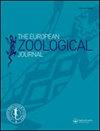Mediimorda Méquignon两个同域物种的系统发育结构,1946(蛾科,鞘翅目)
IF 1.4
4区 生物学
Q2 ZOOLOGY
引用次数: 1
摘要
同域分布和合型在近缘种中并不常见,因为偶发杂交可能导致杂交带的形成,破坏同域初始种的分化。在西班牙中部,1946年的Mediimorda msamuquignon、1985年的M. batteni Plaza-Infante和1827年的M. bipunctata是严格同地分布的。巴attenmediimmorda batatteni是伊比利亚半岛特有的,而bipunctata则广泛分布于古北西部地区。有趣的是,在密切相关的分类群中表现出很少形态变化的同域分布并不常见。这让我们怀疑,我们是否真的像之前提出的那样,面对着两个独立的Mediimorda进化单位,或者仅仅是一个分类单元的两个表型形态。为了验证这一假设,我们基于线粒体(cox1)和核(ITS2)数据进行了贝叶斯分析和系统地理分析,并估计了进化支的分化时间。此外,还包括形态学修正和潜在分布模型的构建,以确定可能的生态位差异。我们的结果证实了两个分化良好的谱系的存在,它们可能在上新世分化。根据形态,每个分支对应于先前识别的巴atteni和bipunctata。杂交和生态分离的缺失表明,同域和合地分布是在两个类群分离的物种形成事件发生后很长时间才完成的。我们认为,这两个分支的分化起源于上新世晚期的异域物种形成,随后在更新世气候振荡期间发生了范围转移,从而形成了两个分类群目前的格局。本文章由计算机程序翻译,如有差异,请以英文原文为准。
Phylogeographic structure of two sympatric species of Mediimorda Méquignon, 1946 (Mordellidae, Coleoptera)
Abstract Sympatric distribution and syntopy are not common in closely related species since sporadic crosses may lead to the formation of hybrid zones disrupting the differentiation of sympatric incipient species. In Central Spain two morphologically similar species of Mediimorda Méquignon, 1946, M. batteni Plaza-Infante, 1985 and M. bipunctata (Germar, 1827) are strictly sympatric. Mediimorda batteni is endemic to the Iberian Peninsula while M. bipunctata is widely distributed in the Western Palaearctic Region. Intriguingly, sympatric distribution among closely related taxa that exhibits little morphological variation is not common. This makes us wonder if we are really facing two independent evolutionary units of Mediimorda as previously proposed or just two phenotypic morphs of a single taxon. To test for this hypothesis, we performed Bayesian and phylogeographic analyses based on mitochondrial (cox1) and nuclear (ITS2) data and estimated divergence time of clades. Additionally, a morphological revision and construction of potential distribution models were included to determine possible niche differences. Our results corroborate the existence of two lineages well differentiated, that probably diverged during the Pliocene. According to the morphology, each clade corresponds to the previously recognized M. batteni and M. bipunctata. The absence of hybridization and ecological segregation suggests that sympatric and syntopic distribution was accomplished long time after the speciation event that separated the two taxa took place. We propose that the divergence between clades was originated by allopatric speciation during the Late Pliocene subsequently followed by range shifts during the Pleistocene climatic oscillations, which resulted in the current syntopy of the two taxa.
求助全文
通过发布文献求助,成功后即可免费获取论文全文。
去求助
来源期刊

European Zoological Journal
Agricultural and Biological Sciences-Animal Science and Zoology
CiteScore
3.10
自引率
5.60%
发文量
80
审稿时长
30 weeks
期刊介绍:
The European Zoological Journal (previously Italian Journal of Zoology) is an open access journal devoted to the study of all aspects of basic, comparative and applied protozoan and animal biology at molecular, cellular, tissue, organ, organismal, population, and community-ecosystem level. Papers covering multiple levels of organization and integrative approaches to study animal form, function, development, ecology, evolution and systematics are welcome. First established in 1930 under the name of Il Bollettino di Zoologia, the journal now has an international focus, reflected through its global editorial board, and wide author and readership.
 求助内容:
求助内容: 应助结果提醒方式:
应助结果提醒方式:


